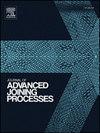The Influence of temperature on the microstructure and properties of Cu/Al tube joints in magnetic pulse-assisted semi-solid brazing
IF 4
Q2 MATERIALS SCIENCE, MULTIDISCIPLINARY
引用次数: 0
Abstract
This study addresses the technical challenge of copper/aluminum (Cu/Al) tube joining through the innovative application of magnetic pulse-assisted semi-solid brazing (MPASSB) technology. Through an integrated approach combining finite element simulation with microstructural characterization, this study systematically investigates how brazing temperature (390–440 °C) influences the microstructure and mechanical properties of Cu/Al tube joints. Notably, a novel finite element method-smoothed particle hydrodynamics (FEM-SPH) coupling model has been developed. This model enables precise simulation of fluid-solid interactions between tubes and filler metal during the brazing process, providing fresh insights into oxide layer removal mechanisms. The research reveals that brazing temperature serves as the critical parameter governing the elemental diffusion and microstructural evolution in the joint. As the temperature increases from 390 °C to 440 °C, the viscosity coefficient of the filler metal decreases significantly from 41.6Pa·s to 1.798Pa·s, resulting in enhanced fluidity that promotes interfacial interactions between the tubes and filler metal and effectively removes surface oxide films, thus improving joint quality. However, excessive temperature intensifies the filler metal ejection, increasing the risk of filler metal deficiency at the top of the joint. Mechanical testing demonstrates that joints brazed at 440 °C achieve optimal shear strength of 81.1 MPa, with fracture occurring at the copper-side (Cu-side) interface between the Al4.2Cu3.2Zn0.7 intermetallic phase and the diffusion layer. This work establishes fundamental theoretical guidance for optimizing MPASSB process parameters and facilitates the efficient joining of Cu/Al tubes.
温度对磁脉冲辅助半固态钎焊Cu/Al管接头组织和性能的影响
本研究通过磁脉冲辅助半固态钎焊(MPASSB)技术的创新应用,解决了铜/铝(Cu/Al)管连接的技术挑战。本研究采用有限元模拟与微观组织表征相结合的方法,系统研究了钎焊温度(390 ~ 440℃)对Cu/Al管接头微观组织和力学性能的影响。值得注意的是,本文提出了一种新的有限元方法-光滑颗粒流体动力学(FEM-SPH)耦合模型。该模型能够精确模拟钎焊过程中管道和填充金属之间的流固相互作用,为氧化层去除机制提供新的见解。研究表明,钎焊温度是控制接头中元素扩散和组织演变的关键参数。随着温度从390℃升高到440℃,填料金属的粘度系数从41.6Pa·s显著降低到1.798Pa·s,流动性增强,促进了管材与填料金属之间的界面相互作用,有效去除表面氧化膜,提高了接头质量。然而,过高的温度加剧了填充金属的喷出,增加了接头顶部填充金属不足的风险。力学试验结果表明,440℃钎焊接头抗剪强度为81.1 MPa,断裂发生在Al4.2Cu3.2Zn0.7金属间相与扩散层之间的铜侧(cu侧)界面。该工作为优化MPASSB工艺参数提供了基础理论指导,促进了Cu/Al管的高效连接。
本文章由计算机程序翻译,如有差异,请以英文原文为准。
求助全文
约1分钟内获得全文
求助全文

 求助内容:
求助内容: 应助结果提醒方式:
应助结果提醒方式:


